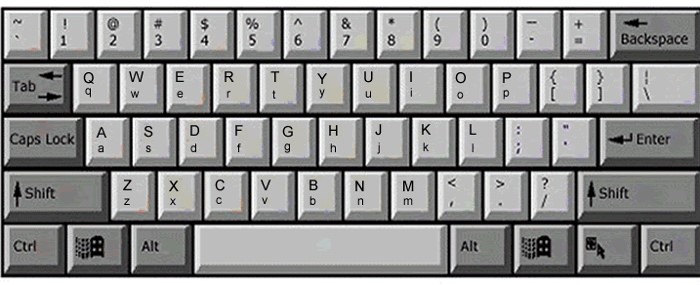Fundamentals of Computer > Input Devices > Standard Keyboard
Standard Keyboard Layout
Keyboard is the primary input device for entering letters, numbers and special characters. It is also used for issuing commands.
- Keyboard comes in a variety of size, shapes and weight, but most keyboards, called standard keyboards, have a certain number of features in common.
The standard keyboard layout used today is the IBM Enhanced Keyboard. It has 101 or more keys arranged in five groups:
- Alphanumeric Keypad/ Standard Type-writer Keys
- Numeric Keypad
- Function Keys
- Cursor Movement Keys
- Special Purpose Keys
Alphanumeric Keypad/ Standard Type-writer Keys:
In general these keys are used to type in text and other data.
- These keys are so arranged that they look like a type-writer.
- Sometimes this arrangement is called the QWERTY layout because the first six keys on the top row of letters are Q, W, E, R, T, and Y.
- This keypad contains some keys such as Shift, Ctrl (control), and Alt (alter) which are called modifier keys. They are called so because, they modify the input of other keys.

Numeric Keypad:
These keys are used to enter numbers for mathematical manipulation.
- It is usually located on the right side of the keyboard and it looks like an adding machine with its ten digits and mathematical operators (+, -, *, and /).
- This keypad features a Num Lock key, which forces this keypad to input numbers.
- When Num Lock is deactivated, the keys of this keypad perform cursor movement control and other functions such as MouseKey etc.

Function Keys:
The function keys labeled F1, F2, F3, ….. and so on are usually arranged in a row along the top of the keyboard.
- They are used to issue commands without keyboarding long strings of characters or navigating menus or dialog boxes.
- The purpose of each function key depends on the program you are using. For example, in most programs, F1 is the help key. When you press it, a screen displays information about the program you are using.
![]()
Cursor Movement Keys:
These keys are used to move cursor around the screen.
- They include Arrow Key (Up, Down, Right, and Left arrow-key), End, Home, Page Up and Page Down keys.
- Cursor movement keys are also used for playing games.
 |
 |
Special Purpose Keys:
Some keys on the keyboard have specific functions which you may not be familiar with. They are special purpose keys.
- These keys include Esc, Print Screen, Scroll Lock, Pause, Start or Windows key, Shortcut or pointer key, etc.
- Special keys are found on keyboards often referred to as a multimedia keyboard.
Feedback
ABOUT
Statlearner
Statlearner STUDY
Statlearner